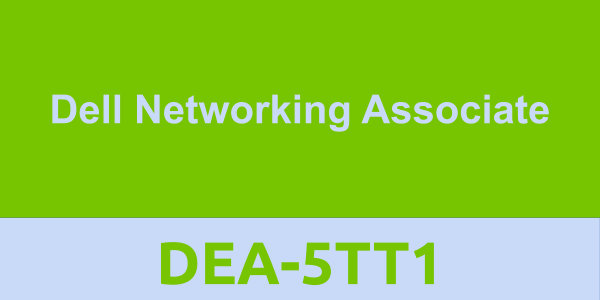This exam focuses on basic Networking foundational skills and portfolio introduction.
Dell Technologies provides free practice tests to assess your knowledge in preparation for the exam. Practice tests allow you to become familiar with the topics and question types you will find on the proctored exam. Your results on a practice test offer one indication of how prepared you are for the proctored exam and can highlight topics on which you need to study and train further. A passing score on the practice test does not guarantee a passing score on the certification exam.
Dell EMC Networking Associate Exam Summary:
| Exam Name | Dell Certified Associate - Networking |
| Exam Code | DEA-5TT1 |
| Exam Price | $230 (USD) |
| Duration | 90 mins |
| Number of Questions | 60 |
| Passing Score | 60% |
| Books / Training | Dell EMC Networking Concepts and Products |
| Sample Questions | Dell EMC Networking Associate Sample Questions |
| Practice Exam | Dell EMC DEA-5TT1 Certification Practice Exam |
Dell EMC DEA-5TT1 Exam Syllabus Topics:
| Topic | Details | Weights |
| Networks – The Basics | - Explain the purpose and function of network devices such as switches and routers, WANs and LANs, and common Campus and Datacenter topologies - Explain the purpose and basic operations of the OSI model - Describe the concepts and use cases for Layer 2 - Data Link Layer, Discovery protocols |
7% |
| Ethernet Networking | - Describe Ethernet networking - Describe the standards of how Ethernet operates and how addressing is used to move data on the Ethernet network |
7% |
| Switching Fundamentals and Creating a Switched Network | - Explain the reason for network switching and the process of moving frames within a switched network - Explain how to differentiate between a broadcast domain and collision domain - Explain how to select cabling and the cables that are certified for network connectivity - Describe the concepts of VLANs, Spanning-Tree protocol, and Link Aggregation and how each functions within the network |
23% |
| Internet Protocol v4 and v6 | - Identify and describe the differences between private and public IP addressing, and describe classful and CIDR addressing - Describe IPv4 addressing and explain the process of using IPv4 in the network - Describe IPv6 addressing and explain the process of using IPv6 in the network |
14% |
| Transport Layer | - Describe the function of the Transport layers, how it supports host-to-host connectivity, and protocols used by the Transport layers and their use cases | 7% |
| IP Routing Technologies and Routing Protocols | - Describe basic routing concepts and explain how to interpret a routing table - Identify and describe the differences between static and dynamic routing - Identify and describe the classifications of routing protocols and how they are used to route within and between autonomous systems - Explain the routing process used by RIPv2, OSPF, and BGP (link state and distance vector routing) routing protocols |
15% |
| IP and Network Services | - Describe the DHCP and NTP service and explain the configuration steps - Describe Access Control Lists (ACLs) and Network Address Translation |
7% |
| Security, Authentication, and ACLs | - Describe the options and processes of securing access to the network | 3% |
| Switch Stacking, Dell EMC Campus, Datacenter, and Modular Switch Portfolio | - Describe the key concepts of stacking and the hardware required to configure stacking using OS 6, OS 9, and OS 10 - Describe the switch models that are part of the Dell EMC Campus, Datacenter, and Modular Switch portfolio |
10% |
| Dell EMC Switch Software, Configuration, and Management | - Explain how software is used to configure and manage Dell EMC switches, and describe the steps to complete an initial switch configuration | 7% |





0 comments:
Post a Comment